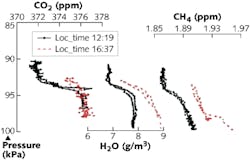OA-ICOS spectroscopy measures atmospheric methane
Cavity-enhanced laser-based methane analyzers from Los Gatos Research (LGR; Los Gatos, CA) have enabled scientists to measure methane-gas venting fluxes in extreme Arctic conditions from a helicopter in real time. Scientists from the University of Alaska (Fairbanks, AK), the Russian Academy of Sciences (Vladivostok, Russia), and Stockholm University (Stockholm, Sweden) are publishing a case study on escaping methane plumes from East Siberian Arctic Shelf (ESAS) sea sediments and found that traditional gas chromatography and other laser-based instruments were too expensive, slow, temperature- and pressure-sensitive, and subject to optical misalignment compared to LGR’s patented off-axis integrated cavity output spectroscopy (OA-ICOS) system.
The scientists reported that the fully automated OA-ICOS system was not only compact, self-contained, and maintenance-free, but accurate enough to gather methane mole-fraction data from a flying helicopter at remote sensing distances with much higher dynamic range (part-per-billion to several percent) than other spectroscopy-based technologies. The data obtained from the LGR instruments showed that total annual flux for methane emissions from ESAS (8 teragrams, or 8 Tg) is nearly equivalent to the total estimated emissions from all the world’s oceans. Contact Doug Baer at [email protected].

Gail Overton | Senior Editor (2004-2020)
Gail has more than 30 years of engineering, marketing, product management, and editorial experience in the photonics and optical communications industry. Before joining the staff at Laser Focus World in 2004, she held many product management and product marketing roles in the fiber-optics industry, most notably at Hughes (El Segundo, CA), GTE Labs (Waltham, MA), Corning (Corning, NY), Photon Kinetics (Beaverton, OR), and Newport Corporation (Irvine, CA). During her marketing career, Gail published articles in WDM Solutions and Sensors magazine and traveled internationally to conduct product and sales training. Gail received her BS degree in physics, with an emphasis in optics, from San Diego State University in San Diego, CA in May 1986.
